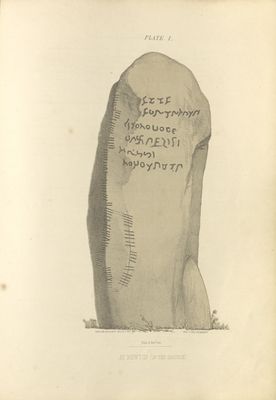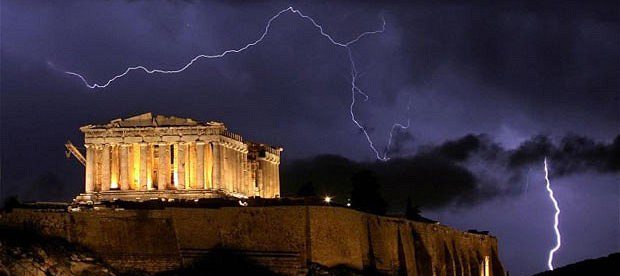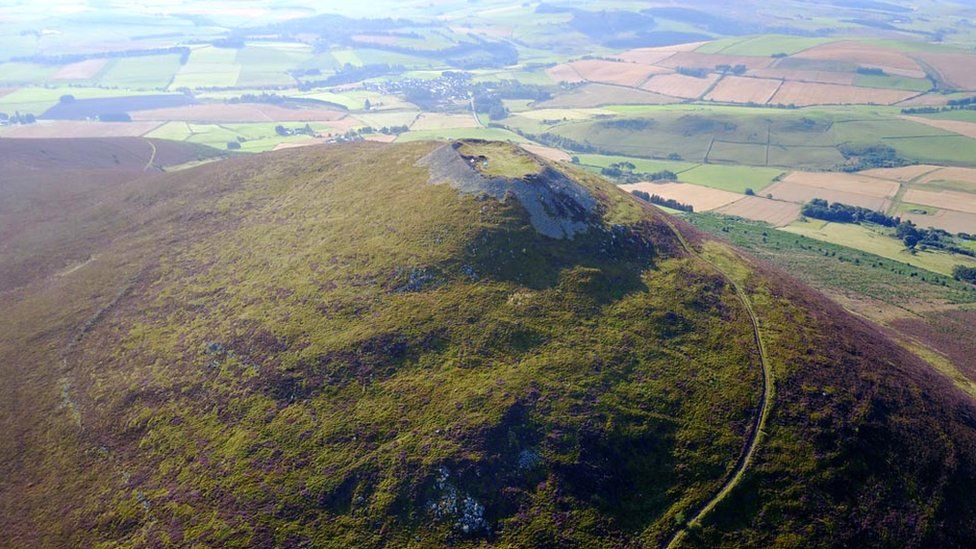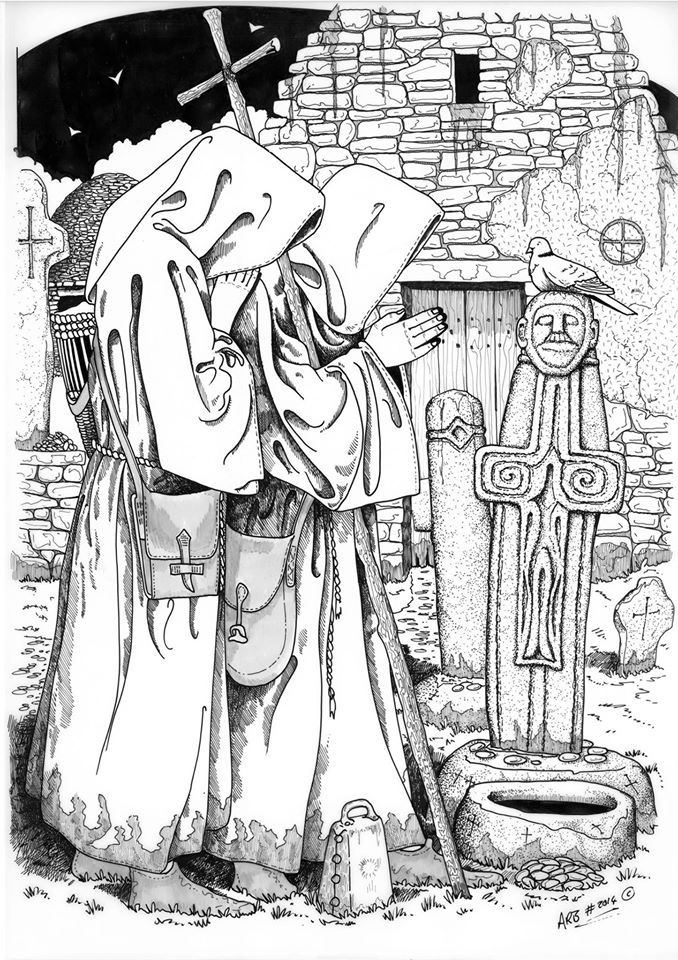Forgotten Monastery
One of the most Famous of the pre-Columban Missionaries in Aberdeenshire was St Moluag (Molocus or Lugadius as he is called in the Latin Records). Unlike most of our Celtic Apostles, he did not come from Strathclyde, but from the Great Monastery at Bangor in Ulster: “Bangor of the Hosts” as it was called, from the 3,000-Monks which it numbered in its greatest days. From this Famous Monastery, which Founded Colonies as far away as Switzerland & Lombardy, St Moluag was sent into Pictland in 562, the year before Columba Established his Community at lona. St Moluag laboured in Argyll, Ross & Banff, but he is pre-eminently associated with Aberdeenshire. Three of his Churches are in the Valley of the Dee – Tarland, Migvie & Durris. Others are at Newmachar & Clatt.
The Great Apostle of Aberdeenshire died while Labouring in the Garioch on 25th June, 592 & was Buried at his Monastery of Rosemarkie in Ross-shire. His Crozier, the Bachuill Mhor, is still preserved, a remarkable Relic of the early Celtic Church, in the Hereditary Guardianship of the Duke of Argyll. “It is a dull intelligence,” Mr Scott truly remarks, “which is not startled by the Survival of this Pastoral Staff into the 20thC.
This Crozier or Bishop’s Crook 34-Ins Long is believed to have been Found under a Pictish Symbol Cross-slab at Rosemarkie Church. It may have belonged to St Moluag, an Irish Monk who is said to have Founded a Monastery at Rosemarkie in the 2nd-half of the 6thC. His Crozier or ‘Bachiul Mhor‘ (Great Staff) is a piece of Blackthorn which would have originally been Encased in Copper Metal. Custody of the Staff was entrusted to the Livingstone Family in Bachuil Village. The Family holds the Ancient Title of Barons of Bachuil.

It is interesting to note that the Famous Newton Stone at Insch may be a Relic of his Activities in Aberdeenshire, for a recent Version of its mysterious Inscription contains the name of Moluag. If so, this Stone is surely one of the most impressive Memorials of the Dawn of its Recorded History which our County can Boast.
Discovered in 1804 when George Hamilton-Gordon, the Earl of Aberdeen, was laying a Road near Pitmachie Farm in Aberdeenshire, the Scottish Antiquarian Alexander Gordon later moved this Enigmatic Megalith to the Garden of Newton House, in the Parish of Culsamond about a mile North of Pitmachie Farm.
“Newton Stone is of Blue Gneiss & is around 2.03M high. It has 6-horizontal Lines of Characters Inscribed at the Top which were thought to be a debased Roman Script, the meaning of which is unknown. To the left of this, down the Side of the Stone, runs an 9thC Ogham Inscription. It contains a personal name (Ethernan) & additional material that is either Incomplete or not wholly Legible. An incised ‘Kidney-bean‘ Shape was observed on the Lower Side of this Stone, identified as a possible Pictish Mirror Symbol.” Around the back, just above Ground level, a Spiral has also been noted. We cannot be sure of the Order in which these Carvings were made, or over how Long a time. This Stone originally stood in a Plantation near Shevock Toll-bar (NJ 6676 2883), on the Slope of a Hill above Shevock Burn, reportedly 1-km South of Newton House. Graves were discovered nearby but their Connection with the Stone is not proven.
The 2nd Stone is a roughly Pillar-shaped of Blue-Grey Gneiss around 2.06M high. The Designs it bears are a notched double-Disc over a Serpent & Z-rod. Prior to its move to its present Location it is said to have been located on the March between Newton & Rothney, 0.7-km West of the Toll-gate of Shevock about 1.4 km South of Newton House.
It as refresing to turn to a seeminly Sane re-ordering’, which has been lately submitted to the Society of Antiquaries of Scotland by Dr William Bannerman, Edinburgh, a Native of Banff & a Graduate in Arts & Medicine of tihe University of Aberdeen, who has paid much attention to Celtic Antiquities. “The conclusions arrived at” by Dr Bannerman “differ in some important respects from others, already brought forward & it is hoped they ‘may be found not unworthy of consideration & criticism, if not of acceptance. The 1st of these is that the letters, debased as they are in form, follow the Celtic rather than the Roman Type.” On this supposition, Dr Bannerman subjects the Inscription, line by line & letter by letter, to a very careful Scrutiny, which leads to this result:
ETITE
CUNANMIAIN
MAOLUOLOEG
UN + ROFTlS . I
H – INNSI
LOAOARUIN.
“Here.” he remarks, “is no unknown Iongue it is old Gaelic, the Language of the Book of Deer‘ & of the Celtic Manuscripts on which Zeuss based his Analysis in the ‘Grammatica Celtica‘; and it will bear critical examination according to its own Grammatical Rules.” This Dr Bannerman proceeds to demonstrate in a series of lucid & convincing arguments combining to yield a result having a show of reasonableness possessed by no previous rendering. In plain English the Gaelic of the Inscription means:
Draw near
to the soul
of Moluag.
from whom came knowledge of the faith. He
was of the Island of Lorn.
“The History,” adds Dr Bannerman, “of Saint Moluag & his connection with Lorn & with the Mountainous parts of the Shires of Aberdeen & Banff are too well known to call for more than the briefest notice. He built his Head Church, as our inscription recalls, on an Island in the Firth of Lorn, which from that circumstance acquired the name of Lismore, He also Founded Rosmarkie & in the Northeastern District his name is associated with Mortlach, with Glass, with places in the Lordship of Strathbogie. with Logie-Mar, with Clatt & others.” The Collect for his day in the Breviary of Aberdeen sounds like an Echo from the Newton Stone. ‘Deus, qui per predicationam beati Voloci confessoris tui atque pontificis populum in tenebris ambulantem a cultu ydolorum convertisti; presta ut pia ejus intercessione omnium nostrorum corda ad cultum vere religionis convertantur. Per Dominum‘. The Annals of Tighernae thus record his death – AD-592. Obitus Lugdach Lissmoir. i. Moluoc.”
P J Anderson, University Library, Aberdeen. c.1908
The most important of St Moluag’s Foundations in Aberdeenshire was at Clova in Kildrummy. His choice of this Locality for a Missionary Centre is amply justified by the Earth Houses & other evidences of a thriving Prehistoric Population with which this District is crowded. The Site is a gentle Eminence on the left Bank of the Little Mill Burn, a small Tributary of the Mossat which rises in Hill of John’s Cairn. It is just East of Little Mill Smiddy & slightly over half a mile South of Clova House, or a mile South-west of the Village of Lumsden. Near it is, or was, Simmerluak’s (St Moluag’s) Well. Within a Plantation may still be seen the rubble Foundations of the Parish Church of Cloveth, which in Medieval Times took the place of the old Celtic Monastery. They indicate a Building about 30.66-ft Long by 21.33-ft Broad exteriorly, oriented to North-east. The Walls were apparently some 2.66-ft thick: but as the whole Southside of the Building has been completely Wrecked & lies buried under a heap of Stones, it is not possible to give very precise dimensions. One or 2-Dressed Slabs still lie about the Site & in the Grounds of Clova House are preserved a number of Fragments which show that the Little Church was not without Architectural Pretensions. These fragments comprise large portions of a square headed Window with a splayed Central Mullion; several splayed Rybats & Lintels ; a portion of the Font & 1-Finely Wrought Stone with Mouldings whose deep hollows & bold Rolls seem to indicate a date in the 13thC. In Clova House are also preserved 4 remarkable Stone Crosses which were Dug up in 1875 in the Old Churchyard. They are quite plain & roughly Hewn, or rather hacked out & may well be Relics of the early-Celtic Monastery. All were found Erect beneath the Surface of the Soil into which they had Sunk, and associated with them were traces of Interment. The Museum at Clova also contains a remarkable perforated Bead in dark Blue Stone, veined in white, red, light blue & green, which was found in 1876 under the North-west Corner Stone of the Foundations of the Ancient Chapel.
Standing on this very Ancient & Sacred Site, is it not strange to think of it as the Scene of a busy little Culdee Community, where Manuscripts were read & copied & where Schools were Established to spread Religion & Civilisation among the rude Inhabitants of Kildrummy & Auchindoir, at a Period when the adjoining Earth Houses may still have been Inhabited & when Beacons blazed often on the Vitrified 3rdC Fort at Tap o’ Noth to give warning of approaching War? Still more remarkable is the reflection that our remote District was Witness of such Godly Labours at a Period when in the West of Europe the Lombard Hordes were pouring into that part of Italy to which they gave their name & Wresting the Conquests of the great Justinian from the nerveless grasp of his Successors ; when at Rome Pope Gregory I was at the height of his Power; when in the East the Empire was locked in that Titanic struggle with Persia from which by the Genius of Heraclius it emerged Triumphant, only to be humbled almost to the Dust before the rival Might of Islam; at a Period, also, before St Augustine had Landed in the Pagan wilds of Saxon Kent & when St Columba had barely commenced his great Work among the Scotic Immigrants of Dalriada.
We may readily picture our little Community, with its group of Wooden or Wattle Huts, its Smithy, its Barns & Byres, its Bakery, its Kiln for Corn-drying, and its little heather-thatched Church of un-cemented Stone – all enclosed by a fencible dry-Built Wall & Earthen Bank, and surrounded by the neat patches of cultivated Soil upon which the Holy Brethren worked. The life of the Inmates, too, may be realised with tolerable clearness from a consideration of the well-known characteristics of Celtic Missionary Monasticism. Most of them would be Laymen, exempt from the heavy duties of Religious Service & wholly taken up with the practical work & manual labour of the Community. The Religious Brethren, or Monks proper, were grouped into 3-Classes – the Seniors, who were old men past active Work & rich in Holiness ; the Working Brethren, on whom the main Burden of the Missionary & Educational Work of the Monastery was Cast & the Juniors, or Novices under Instruction. The system of Devotional Exercises was very severe. A feature was the Laus Perennis, or “Perpetual Praise” maintained in the Church day & night by relays of Brethren. Thus in the Life of St Kentigern, we have an account of his Monastery at Llanelwy in North Wales, in which it is stated that 365-Monks, “divided into Companies, so that the praise of God never ceased,” “devoted themselves to the Divine Office in Church by Day & by Night & scarcely ever went Forth out of the Sanctuary” – that is, the Coynraich or Sacred Precincts of the Monastery. The Dress of these Monks was of the simplest form, consisting of a Shirt reaching to the Heels & an Upper Garment with Hood & Sleeves; Shoes of Hide & a White Surplice for use at Festivals. All Classes lived with the greatest Austerity, sleeping on Beds of Stone, or at the best on Boards covered with Straw ; each Monk had his own Cell or Hut & Celibacy at any rate in the Early & Best days of Celtic Monasticism was strictly enforced. Up in the surrounding Hills – in the Correens or in the Wilds of the Cabrach – would be the “Diserts,” or Retreats whither the Holy Brethren would withdraw on occasion for Solitary Meditation. These Hermitages were a great characteristic of the Celtic Monasteries. On the Southside of Tap o’ Noth, looking towards Clova, is an immense jutting Rock called Cloch-Malew, “the Stone of Moluag,” which no doubt formed the Disert or Retreat of the Saint while Labouring in these parts.
In addition to the Work connected with the maintenance of the Civil & Religious Life of the Monastery, there was also the Missionary activity of which each Community was a Centre. The Brethren would go forth, generally in couples, for long Periods, sometimes months on end, Preaching to the Natives & setting before them the Ideals & Standard of a Christian life. Moreover, every Monastery possessed its School & we also know that they provided Systematic Teaching in Agriculture & gifted Seed to the Faithful in the neighbourhood. In the Life of St Nathalan occurs the wise & beautiful remark that “among the Works of Men’s Hands the Cultivation of the Earth approaches nearest to Divine Contemplation” & this thought was fully translated into Practice by the Celtic Church. In the East, Monasticism abandoned itself to purposeless & selfish Introspection: in the West, on the Lines Established by St Martin of Tours & strictly maintained by St Ninian & his School in Scotland, it became an Institution of the highest practical value for the spreading of Spiritual & Material Blessings. It has been well pointed out that whereas the Medieval Monastery was a Refuge whither men fled from the Vices of their fellow-men, the Monastery in Celtic times was a Training School for Warriors who boldly issued Forth to Wrestle with the Evil around them.
We know very little of the Community at Clova during the 600-yrs of its activity. Its Founder placed it under the larger Settlement which he had Planted at Mortlach in Banffshire. Practically the only notice of it which has been preserved amid the darkness of those early-Ages tells us that the Church & Lands of Cloveth were confirmed by Malcolm Canmore to the Parent Monastery at Mortlach. This Grant, however, which is dated 1062, “has been,” in the words of our great Legal Antiquary, Cosmo Innes, “very generally Denounced as a palpable Forgery”. After long continuing to fulfil the high purpose of its Founder, the little Monastery at Clova was finally merged in the Anglo-Norman Parochial System which replaced the old Celtic Missionary Organisation in the 12thC. In 1157 a Bull of Pope Adrian IV assigned the Town & Monastery of Mortlach, with its 5-Dependent Churches & the Monastery at Cloveth, to the See of Aberdeen. It has been conjectured that the old Celtic Christianity still retained its hold upon the Inhabitants, since we are told by Hector Boece that Gilbert de Sterling, Bishop of Aberdeen from 1228 to 1239, recovered Cloveth from “Wicked Highlanders“. Thereafter Cloveth became a Parish & the Ancient Monastery was replaced by the Parochial Church whose Foundations remain & which in the Roman fashion was dedicated to St Luke. Luke was probably deliberately chosen by the Romanists from the resemblance of his name to that of Moluag, particularly when the honorific prefix ” Mo ” is omitted – the form which is Latinised as Luanus or Lugadius. Macfarlane’s Topographer, writing in 1725, speaks of a “Chapel dedicated to St Luke called Sommiluak’s Chappel, formerly much frequented by all the Northern Pariochs“. His Testimony to the fame of the Ancient Monastery is powerfully reinforced by the fact that the name of its Celtic Founder has outlived both the Roman Dedication & the Faith of Rome itself.
In the 14thC, as a result of the disturbances & impoverishment caused by the great struggle with the Plantagenets, it was considered advisable to Merge the Parish of Clova in Kildrummy. The 2-Parishes, we are told, had been “devastated over & over again by War “. Probably the Military Operations connected with the 2-Sieges of Kildrummy Castle, in 1306 & 1335, had pressed heavily on the District. The Union between the 2-Parishes was accordingly carried out on 18th January, 1362 & was duly approved by Alexander, Bishop of Aberdeen, on 4th April, 1364.’ Thereafter the Church of Cloveth fell to Ruin, and the Ecclesiastical History of this Ancient & Holy Site came to an end.
Although the Foundations of the Medieval Church are well nigh gone & nothing whatever remains of the Turf & Wooden Buildings which made up the old Celtic Monastery, it is impossible to visit this Venerable & Historic Site without feelings of profound emotion, when we consider the noble work which was here accomplished at the very dawn of our Country’s recorded Annals. No finer task has perhaps been entrusted to man than was given these early Missionaries to perform. In a Wild Land, under circumstances of great personal hardship & danger, they lived strenuous lives of the purest self-sacrifice for the great cause to which they were unreservedly consecrated, Body & Soul. Moreover, theirs were Practical lives, rich in well-ordered, fruitful Toil, both Physical & Intellectual. We need not dwell upon the Spiritual uplift caused by the adoption of Christianity in Pictland at large & its Political effect in bringing these out-of-the-way Districts into eventual touch with the main currents of European Development. Not less important was the purely Local work which these Monkish Settlements performed in introducing to the untutored Natives an improved Husbandry & winning them to a higher standard of Social life. It may be freely granted that by the 12th & 13thCs Celtic Christianity had worn itself out & that its absorption in the Church of Rome was necessary & inevitable, both Spiritually & Politically. But let us not thereby allow ourselves to forget the great Work done by the Native Church, although all that remains to tell us of her activities are the forgotten Sites of her perished Monasteries, the Church Foundations & Holy Places which mark the wanderings of her great Apostles & the Legends which have gathered round their names – Legends which, adopted by the Medieval Church & garbled in her interest, have too often served only to obscure the Work of the Primitive Missionaries. – W Douglas Simpson 1896-1968






